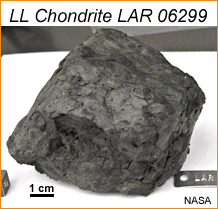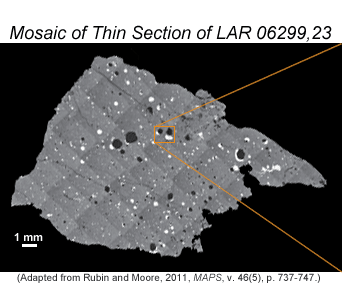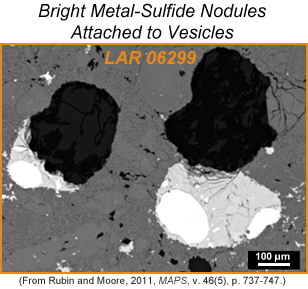Quick Views of Big Advances
A Meteorite with Up and Down Markers
 |
Rubin and Moore suggest that LAR 06299 was located near the surface of its parent asteroid when it was shocked and melted by impact and rapidly cooled. They say the presence of vesicles inside this impact melt breccia indicates volatilization and heating to superliquidus temperatures, perhaps to 1500-1600oC. Some volatile phases, such as sulfur and sodium, formed bubbles in the melted rock. Metal and sulfide grains melted and nucleated on the bubbles to form FeS nodules, most of which contain a metallic Fe-Ni bleb. Intriguingly, they found a preferential alignment of the vesicle-nodule-metal blebs. About 90% of the nodules have the metal blebs aligned on the same side and when these nodules are attached to vesicles, most of the vesicles are positioned on the opposite side of the metal blebs. Gravity on the asteroid oriented the nodule/bubble pairs that grew suspended in the melt so that, in most cases, bubbles moved on top and Fe-Ni blebs moved to the bottom and that's the way they solidified. This density stratification, resulting from alignment in the asteroid's gravitational field, became the unique up and down markers of the rock. Using this information and sizes of the phases in the rock, as well as estimates of the cooling rate of the silicate melt, viscosity of the metal-sulfide melt, and asteroid density, Rubin and Moore found 1.5 kilometers as a bare-minimum radius for the LAR 06299 parent body.
 |
 |
Left: A backscattered electron (BSE) image mosaic shows the melt matrix, vesicles (black), and metal-sulfide nodules (light gray) in LAR 06299. The orange box outlines the location of the enlargement shown on the right. Right: High-magnification BSE image of vesicles (black) and attached metal-sulfide nodules (gray). Note how the metal blebs (white) are on the other end of the nodules, opposite the vesicles. The vesicles show which way was up. Rubin and Moore conclude the alignment occurred in the gravitational field of the >3-kilometer-diameter LL parent asteroid. | |
![]() (pdf version)
(pdf version)
See:
Rubin, A. E., and Moore, W. B. (2011) What's up? Preservation of Gravitational Direction in the Larkman Nunatak 06299 LL Impact Melt Breccia. Meteoritics and Planetary Science, v. 46(5), p. 737-747. [ NASA ADS entry ].
Written by Linda Martel, Hawai‘i Institute of Geophysics and Planetology, for PSRD.
|
|
[ About PSRD | Archive | CosmoSparks | Search | Subscribe ] [ Glossary | General Resources | Comments | Top of page ] |
